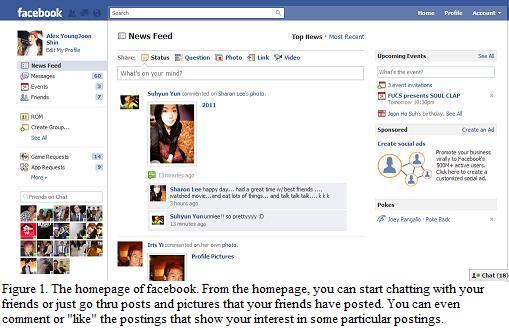Serendip is an independent site partnering with faculty at multiple colleges and universities around the world. Happy exploring!
Socializing in virtual world
In one of the panel discussions in gender and technology class at Bryn Mawr College, each student represented a group whose lives or work circumstances shaped, or were impacted by, an interesting intra-action of gender, information, science, and/or technology. Among the represented groups, there were several students who represented group of people existing in cyberspace. Cyberspace, which is also known as virtual world, is defined by Wikipedia as a “genre of online community that often takes the form of a computer-based simulated environment through which users can interact with one another and use and create objects.”
Discussions about the groups from cyberspace reminded me of the article by Sherry Turkle, “Tinysex and Gender Trouble,” which analyzed how gender roles are represented and social behaviors could be altered in cyberspace. Because of unique aspects of cyberspace, such as anonymity and openness, social interactions in cyberspace among humans have some distinctive features as well. The article by Turkle mainly focuses on the gender aspect of cyberspace, but the panel discussions additionally brought interesting points that relate cyberspace with various social interactions. Based on the panel discussions and the article by Turkle, I got an impression that people have natural desire to socialize, and people who are reluctant or impossible to do so in the real world take advantage of the virtual world for socializing. This is reflected by that the use of technology enormously increased human interactions even though the development of technology and creation of virtual world possibly reduce person-to-person human interaction.
There were two students represented facebook users and both of them focused on the aspects of facebook that it is a way of communicating between “friends.” As mentioned, cyberspace is where people could behave anonymously or even create a false identity. However, facebook, the social network, tends to reflect the real life human relationship better than other means of cyberspace socializing; many users of facebook, according to the panelists, use facebook in order to communicate with their real life friends so that they could keep in touch with them more effectively. Such phenomenon does not seem to correlate with the general belief that humans use online communications in order to meet and socialize with new people. Therefore, it could be concluded that facebook users utilize cyberspace in order to strengthen their social relationship that already exist in real life. It strongly supports the idea that humans are social animals and they even take advantage of advanced technology in order to keep their social relationship as secure as possible.
Students who represented youtube users seem to introduce more non-conventional ways of communicating in cyberspace. While the conventional way of communicating in cyberspace is using texts and chatting, the communicating method of youtube involves videos, which could include visual and auditory information. Since many people believe that visual information is more credible and easily decoded, youtube has served as an import tool for its users to communicate and share information with others. Even if it seems that it would be challenging for its users to communicate by posting videos, youtube users have successfully done it by just commenting on videos or posting a new video, replying to the original post. This process also reflects human desire to socialize in cyberspace very well. However, the social interaction in youtube could be distinguished from the one in facebook by that youtube users tend to communicate with strangers very often, or at least with people who are not their real life friends, while facebook users mostly socialize with their “friends”. Such phenomenon of youtube users also strongly support that humans have desire to socialize even with strangers.

Another interesting feature of youtube was introduced by explaining the revolutionizing role in Arabic countries. Students who represented group of Arabic musicians and teenagers explained that they communicate and socialize with people outside of the Arabic world using youtube. Since visual presentation of information could bring more attention from others, youtube serves as an important tool for socializing among people in different cultures and religions. This example also reflects the human desire to socialize with others in somewhat different way.
Video games that are covered in the panel and in the article reflect a new side of cyberspace and social behavior of humans in it. Some video games offer similar cyberspace experience as facebook and youtube do; users interact with each other in a similar social manner that they would interact in real life. However, users of particular types of video games experience social interactions with other people that they would not experience in real life. For example, users of particular video games are sometimes advised to “kill” other users when they fight against each other. Factually, most people would not act in such a violent way in real life situations, but they act differently because they do not feel responsibility for the actions and social consequences because all the actions are committed in virtual world. Article by Turkle introduced an idea that many online game users believe certain amount of shape-shifting is part of the online game. Such mindset of gamers might also contribute to the fact that they feel less responsible for violent actions in their social interactions. Cyberspace of video game still seems to show that people socialize with others even if their behaviors might vary depending on the situation.
The article by Turkle presents some studies and surveys on people who have interacted with others in cyberspace. So far, we examined the behavior and social interactions of humans in cyberspace, but the behavioral changes that could be induced by the special aspects of cyberspace have not yet been examined thoroughly. Turkle, in that sense, shows interesting cases how humans could interact as they would interact in real life or as they would never do in real life. One of the examples presented about a psychiatrist who pretended to be a disabled woman shows that people are capable of feeling sympathy and care in cyberspace as they would do in real life to their real friends. However, other examples, such as interviews with a teenager girl and internet users who have virtual sex with their on-line partners, show humans are capable of behaving differently in cyberspace social situations as the video gamer examples showed; teenage boys act and say more sexually toward girls and people who would never cheat on their partners have virtual sex with other on-line users.
In conclusion, the examples of cyberspace groups seem to strongly support the theory that humans have natural desire for interacting with others and they take advantage of cyberspace to fulfill their desires and interact with even more people. We can also evidently see that humans behave differently when they are in cyberspace probably because they are less conscious about social consequences. Because of the expanding life in cyberspace, all the internet users, especially the ones who interact with others online socially, need to realize the connection between their physical and virtual bodies and sometimes feel responsible for the actions of their virtual bodies. Then, socializing in cyberspace, which is a natural product of human desire, would create friendlier environment for everyone.
Reference
Sherry Turkle. “Tinysex and Gender Trouble.” Life on the Screen: Identity in the Age of the Internet. Simon and Schuster, 1995. 210-232.
| Attachment | Size |
|---|---|
| facebookpage.jpg | 39.53 KB |
| youtubepage.jpg | 40.35 KB |




Comments
expanded life
This paper very effectively maps out the diversity inherent, but often overlooked, in social networking.
You describe at least three: 1) virtual and unknown identities found in online gaming 2) identities anchored in reality on Facebook, but fascinatingly supporting interactions where one is not obliged to actually interact, one can just lurk and still feel "in the loop", and 3) mixed virtual and real identities presented to audiences in large part not known to the creator, e.g. Youtube.
You raise intriguing questions-- are there less-tethered behavioral consequences to opinions and actions that take place online? How might we determine whether that is what drives online socialization? Where does Twitter fit in? What do you think is the next frontier for online identities and modes of communication?